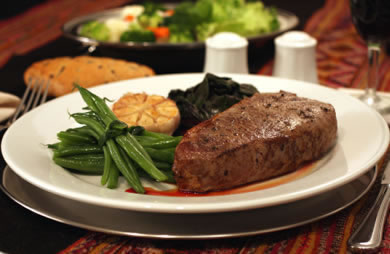|
Busy and hectic lives cause many people to rely on processed and ready-to-serve foods or eating out as the way to quickly get a meal together for their family. The costs of these types of meals tend to be high and the nutrition many times is inferior to home cooked alternatives. Tough financial times require many of us to dig down and find creative ways to continue living our life to the fullest. You have heard that increased intake of processed foods and eating out have a negative affect on weight and health. These types of foods also have a negative affect on your budget when it is tight. Purchasing less processed and ready to serve foods and eating out less in favor of making more foods from scratch can be a great start to stretching your food budget further. Do you know how to make the switch? My mother taught me a great deal about being creative and living well on a budget while I was growing up. Her cookbook of choice for our family of six was the More with Less Cookbook. As I have struggled with hectic schedules and providing healthy meals for my family over the years, I discovered how beneficial my slow cooker can be. I also found a helpful cookbook called Fix-It and Forget-It. As we learned last week, pre-planning helps ensure that we have the ingredients we need on hand which can also save money. Putting everything together in the slow cooker the night before allows you to pull the crock out of the refrigerator in the morning on your way out the door so it can cook all day while you are away. When you get home you can have a healthy dinner on the table in less than thirty minutes or feed your family in shifts if sitting down together isn't in the schedule. Transitioning from dining out or processed meals to cooking at home doesn't have to be an overwhelming process. Keep these principles in mind when seeking to make the switch. Start small - Pick one or two days in the week you can commit to cooking a meal at home. Plan ahead and make sure you have what you need when those days come. As you master one or two days for a couple weeks in a row, stretch it to three days and then stretch to four. Start simple - Picking Chicken Cordon Bleu as one of your recipes initially is probably not a great way to get started. It doesn't have to be fancy to be a quick and well balanced meal. Trying to be too fancy can sabotage your best intentions for change. Start with a safe recipe - Pick easy recipes with basic ingredients. Ask a friend or family member for their favorite quick and easy recipe if you don't have one of your own. The fewer the ingredients the better when you are first getting started. The more success you have with basic but delicious meals at home, the more likely you will be to continue. Start together - Involve the entire family as much as possible. It doesn't matter whether you let each member of the family pick a night for their favorite home cooked recipe or all sit down together to plan the menu for the week. Whatever system works for your family is fine as long as you remember that 'buy in' many times leads to success. Likewise, teaching children to cook at home will go a long way to healthier lifestyles for them as well. Improving your food budget doesn't mean total sacrifice so be sure to plan meals out or your favorite processed meal into your weekly meal plan. This helps the family feel positive about the small changes they are making without having to feel like they must give up everything all at once. Whole grains, lentils, and dried beans can become staples when eating at home and are cheap and readily available. Don't be afraid to try new foods during your journey of cooking more at home. You just might find your waist line shrinks as well as your food costs. Share your favorite quick and easy cook-at-home meal ideas. |
More From SparkPeople
|

.jpg)













